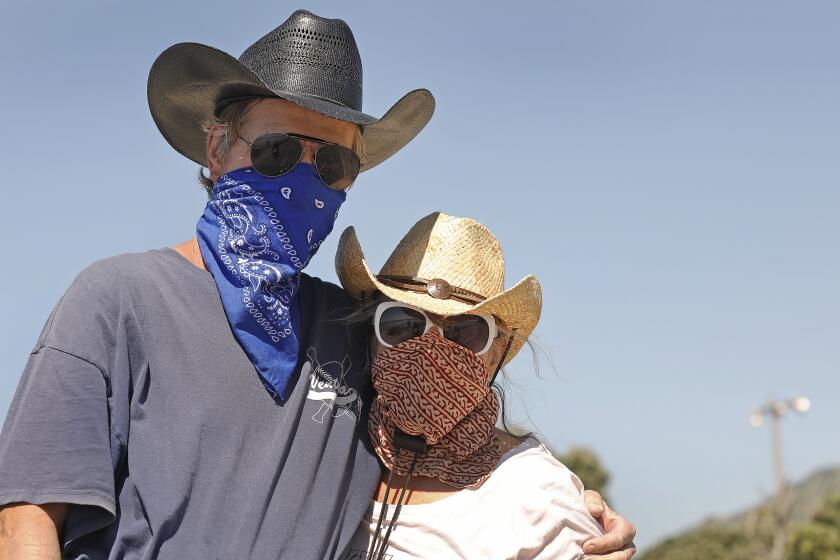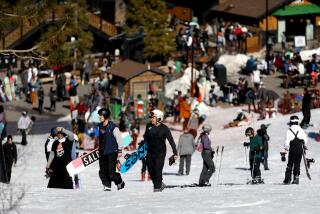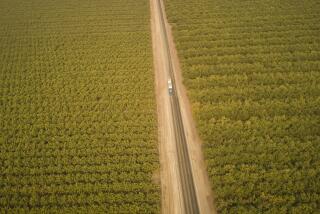From Big Bear to Joshua Tree, officials fight to slow the spread of coronavirus in rural towns

- Share via
As a San Bernardino County supervisor, Dawn Rowe serves communities from high up in the snow-capped San Bernardino Mountains to the edges of the Mojave Desert and the rural outposts in between.
In her 3rd District, one town is facing an outbreak of the novel coronavirus at a skilled nursing facility where five residents have died; a stream of visitors coming into Joshua Tree National Park and parking on private property led to a shutdown of the park; and local officials have been forced to track down those skirting orders to stop housing visitors.
People who live in a rural area understand the trade-offs of choosing to live away from a city and its access to more resources, said Rowe, who lives in Yucca Valley. But a potential spread of the coronavirus could put a strain on their small communities if outsiders continue to come for what locals are calling the “COVID vacation.”
“We have just such limited supplies, we don’t have hospitals that can care for large numbers,” she said. “So it’s not really the place you want to be if you’re sick.”
San Bernardino County officials face a challenge in limiting the spread of the coronavirus because of the area’s size — it is the largest county in the continental U.S., with about 2 million residents spread out over more than 20,000 square miles, including tourist-driven sites such as Big Bear and Joshua Tree National Park.
A large percentage of the county’s population is concentrated in the western region that borders Los Angeles and Orange counties, but officials are working on increasing resources to far-out rural communities across the valley, mountain and desert regions.
The latest updates from our reporters in California and around the world.
“We don’t want anyone to feel like because they live in the mountains, they don’t get the same opportunities as people who live in [the city of] San Bernardino,” said Lana Culp, spokeswoman for the county Public Health Department. “For the most part, we’re struggling just the same as anyone else.”
To meet residents’ demand for testing, county and local officials have set up drive-through sites across the county, ranging from a baseball stadium in Rancho Cucamonga, home to about 177,000 residents, to a parking lot up in the mountain community of Big Bear Lake, where the year-round population is about 5,000.
“We understand the high demand for COVID-19 testing in our county and we are making every effort to organize drive-through events throughout the county,” Curt Hagman, chairman of the county Board of Supervisors, said in a statement.
The thought that rural communities would be immune from the fast-spreading virus was quickly dispelled in the county, which reported 977 confirmed cases of COVID-19 and 31 fatalities Monday. As city dwellers left behind their densely populated surroundings for the space and solitude of the desert and mountains, permanent residents became wary.
Fontana, the second-largest city in the county, has 120 confirmed cases. But in Yucaipa, with about a quarter of Fontana’s population, an outbreak at a skilled nursing facility has driven the total to 104.
Big Bear Lake Mayor Rick Herrick became the first resident in the town to test positive for COVID-19 in mid-March. He does not know how he became ill, he said, but he found it difficult to breathe, made worse by being at an elevation of nearly 7,000 feet.
“It almost felt like I had accidentally, somehow, breathed in toothpicks” that became stuck in his lungs, he said.
Including Herrick, there have been only three confirmed cases in the town, where the daffodils and tulips are starting to appear, but a drive-through testing site on Friday may help identify more, Herrick said.
During a normal year, Big Bear Lake’s population can swell to about 50,000 after receiving a good amount of snow, which it got last weekend, City Manager Frank A. Rush Jr. said. But a virus outbreak on the mountain with that many people could be disastrous; the lone community hospital can accommodate only about 30 patients after boosting capacity, and it has seven ventilators, he said.
So the city has closed hotels and resorts as residents’ concerns mount that visitors could bring the virus with them. Public parking lots have been closed. And while large rental companies have complied by canceling reservations, at least seven groups of visitors have been asked to leave as the city cracked down on self-managing services such as Airbnb, Rush said.
“Normally we’d be welcoming everybody with open arms, so it’s kind of a hard message for us to send, to tell visitors to stay away,” he said.
Yucca Valley Mayor Jeff Drozd expressed a similar struggle as potential visitors contacted him in recent days to see whether he’d rent out his guesthouse — he won’t. The town, which has a state welcome center and is one of the last stops for most people traveling to Joshua Tree National Park, collects revenue from visitors who frequent its shops and restaurants. And although residents will be hit hard by the economic loss, he said, they are conforming to safety measures.
“People are really concerned now,” he said, counting himself among those who initially believed the region was insulated from the virus. “Whatever you think, if it’s real or not, you have to do that to help other people feel at ease.”
In Yucaipa, a town in the foothills of the San Bernardino Mountains, an outbreak at the Cedar Mountain Post Acute Rehabilitation facility accounts for a majority of the city’s mounting cases. Five residents of the facility have died of coronavirus-related complications, the county said.
Elizabeth Tyler, a spokeswoman for the facility, said healthy patients have been separated from those who are infected. A large number of the reported cases were people who were asymptomatic, Tyler said, adding that staff members don’t know how the spread started.
Mayor David Avila has asked for assistance from both the county, to ramp up testing, and the state, which regulates the facility. Most Yucaipa residents have complied with the stay-at-home directives and social distancing measures, he said. Residents have even effectively shamed nonessential businesses on social media for refusing to close, he said.
Avila also counts himself among those who initially believed the region was insulated from the virus.
“We’re kind of out of the way,” he said. “We just had a little, ‘Eh, it won’t come to our town.’ But it did.”
More to Read
Sign up for Essential California
The most important California stories and recommendations in your inbox every morning.
You may occasionally receive promotional content from the Los Angeles Times.













